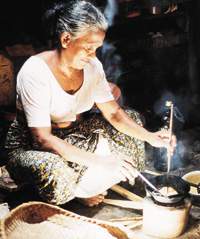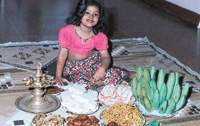| Mirror
Magazine |
||||
|
Bringing
together the old and the new While most
countries follow the Gregorian calendar and celebrate the New Year
on January 1 each year, there are other communities who like the
Sinhalese and Hindus celebrate New Year at a different time. Here
the new year falls on the 13th or 14th day of April and is preceded
by at least two weeks of preparations, devoted largely to shopping
and the making of several varieties of sweetmeats. The constant
bursts of firecrackers and the unmistakable call of the 'koel bird',
popularly known as the 'koha', which coos only at this time of year,
herald the Avuruddha. Although essentially
the same in tradition, there remain a few differences in how the
Tamils and the Sinhalese celebrate the New Year. The New Year approaches
with a pre-determined time for preparing the ceremonial first meal.
Dressed in the year's lucky colour and facing the auspicious direction
housewives prepare a dish of Kiribath from the year's first harvest
of rice, placed reverently at the head of the table, right beneath
an oil lamp. Offerings of
fruits, sweets and flowers are made to Lord Ganesha. Special food
is prepared with particular emphasis on pulses and cereals. In the
afternoon people go to the temple for prayers and the remaining
day is spent visiting relatives and friends and exchanging New Year
greetings. Gifts are given to domestic workers and others. Business
people generally start new account books for the New Year on this
day. Bonuses are often paid on the eve of the New Year. The whole family
will sit for the first meal, soon after transacting some business,
referred to traditionally as ganudenu, or the act of receiving and
giving. The time now is at its most auspicious, so it is believed
that whatever is initiated at this time will undoubtedly be beneficial.
The fun and frolic will continue till it is time for anointing with herbal oil, and the auspicious time for this ceremony falls roughly about three days after the Avuruddha. An adult member of the family will prepare a very special herbal oil made of Nuga leaves and anoint family members, with blessings for a wonderful year to come. With it, Avurudu festivities come to an end and Sri Lanka gets back to its normal pace of life. New Year
celebrations around Asia Preparations
for the festival begin a week ahead. Houses are given a thorough
wash. Shopping for new clothes and buying other items that go with
the requirement of the festival are done with a lot of excitement.
Entrances of the houses are decorated with fresh mango leaves. People
also splash fresh cow dung mixed with water on the ground in front
of their homes and draw colourful floral designs. On Ugadi day,
people awake before the break of dawn and take a head bath. The
bath is supposedly to be taken after massaging the entire body with
sesame oil. The next step is to offer prayers to the Sun. In some
parts of India, the tender leaves of 'Neem' mixed with jaggery are
distributed on this occasion. The neem, extremely bitter in taste
and the sweet and delicious jaggery signify the conflicting aspects
of human life - joy and sorrow. This is exchanged between friends
to symbolize renewed warmth and love overcoming the difficulties
of life. It is also an occasion to forgive old debts and forget
old disputes. The Chinese
New Year (usually in Jan/Feb) is very similar to the Western one,
swathed in traditions and rituals. The origin of the Chinese New
Year is itself centuries old - in fact, too old to actually be traced.
It is popularly recognized as the Spring Festival and celebrations
last 15 days. Preparations
tend to begin a month from the date of the Chinese New Year (similar
to a Western Christmas), when people start buying presents, decoration
materials and food and clothing. A huge clean-up gets underway days
before the New Year, when Chinese houses are cleaned from top to
bottom, to sweep away any traces of bad luck, and doors and windowpanes
are given a new coat of paint, usually red. The doors and windows
are then decorated with paper cuts and couplets with themes such
as happiness, wealth and longevity printed on them. The eve of
the New Year is perhaps the most exciting part of the event, as
anticipation creeps in. Here, traditions and rituals are very carefully
observed in everything from food to clothing. Dinner is usually
a feast of seafood and dumplings, signifying different good wishes.
Delicacies include prawns, for liveliness and happiness, dried oysters
(or ho xi), for all things good, raw fish salad or yu sheng to bring
good luck and prosperity, Fai-hai (Angel Hair), an edible hair-like
seaweed to bring prosperity, and dumplings boiled in water (Jiaozi)
signifying a long-lost good wish for a family. It's usual
to wear something red as this colour is meant to ward off evil spirits;
black and white are out, as these are associated with mourning.
After dinner, the family sits up for the night playing cards, board
games or watching TV programmes dedicated to the occasion. At midnight,
the sky is lit up by fireworks. On the day
itself, an ancient custom called Hong Bao, meaning Red Packet, takes
place. This involves married couples giving children and unmarried
adults money in red envelopes. Then the family begins to say greetings
from door to door, first to their relatives and then their neighbours.
Like the Western saying, "Let bygones be bygones," at
Chinese New Year, grudges are very easily cast aside. The Festival of Lanterns, which is a celebration with singing, dancing, marks the end of the New Year and lantern shows. Although celebrations of the Chinese New Year vary, the underlying message is one of peace and happiness for family members and friends. |
||||
Copyright © 2001 Wijeya Newspapers
Ltd. All rights reserved. |
 It is the season of the Avuruddha, the annual New Year celebration
by the Sinhala and Tamil people of the island, a great national
festival that has persisted in all its traditional glory for no
less than 2,000 years. Recognized officially and observed countrywide
as the National New Year, the celebrations take seven days, varying
only slightly from the age-old venerable traditions, which are still
observed to the letter by most Sri Lankans of all ages and social
background.
It is the season of the Avuruddha, the annual New Year celebration
by the Sinhala and Tamil people of the island, a great national
festival that has persisted in all its traditional glory for no
less than 2,000 years. Recognized officially and observed countrywide
as the National New Year, the celebrations take seven days, varying
only slightly from the age-old venerable traditions, which are still
observed to the letter by most Sri Lankans of all ages and social
background.